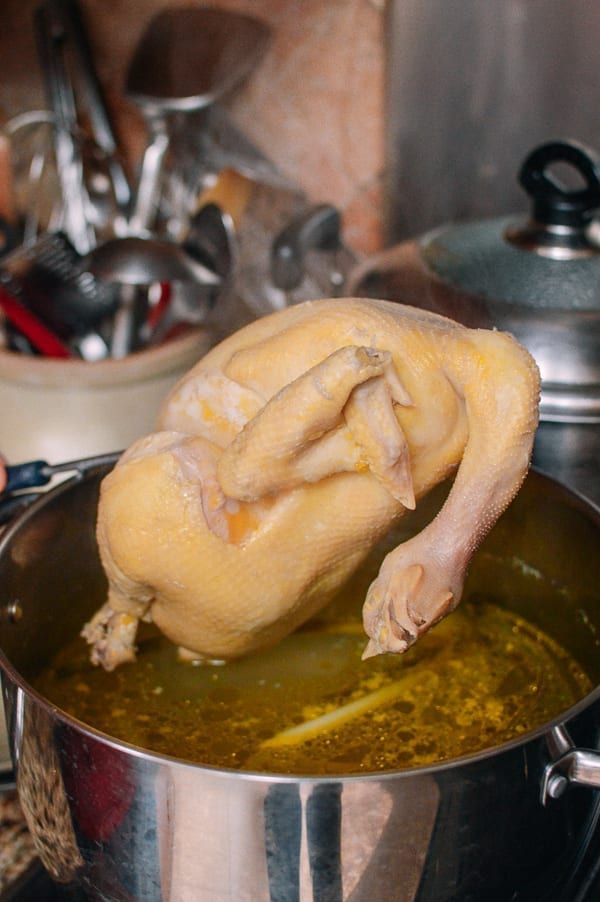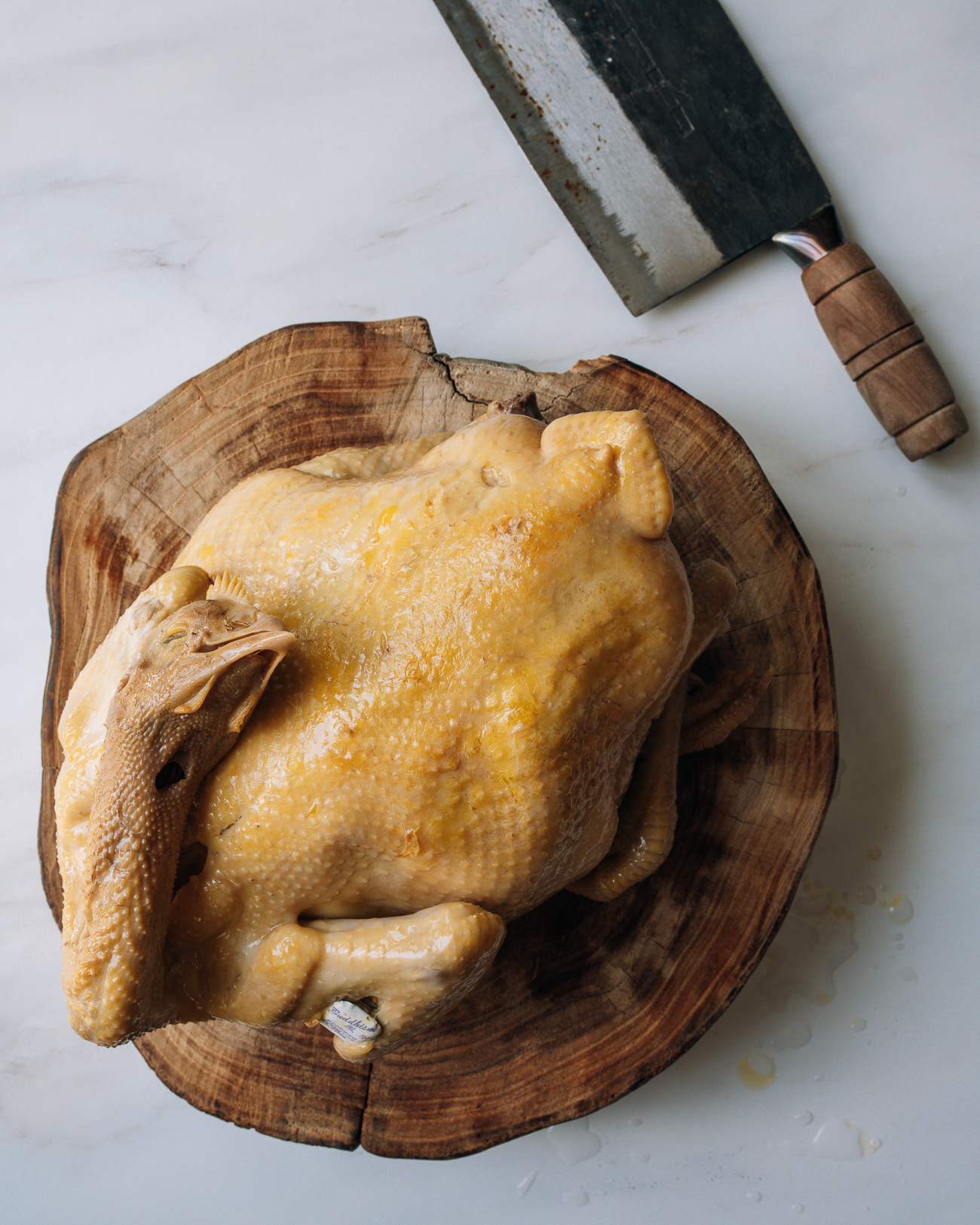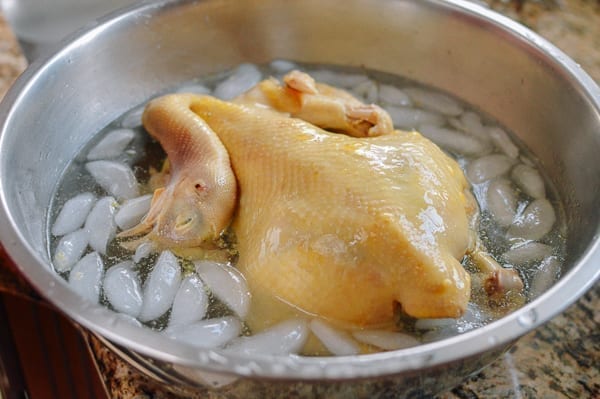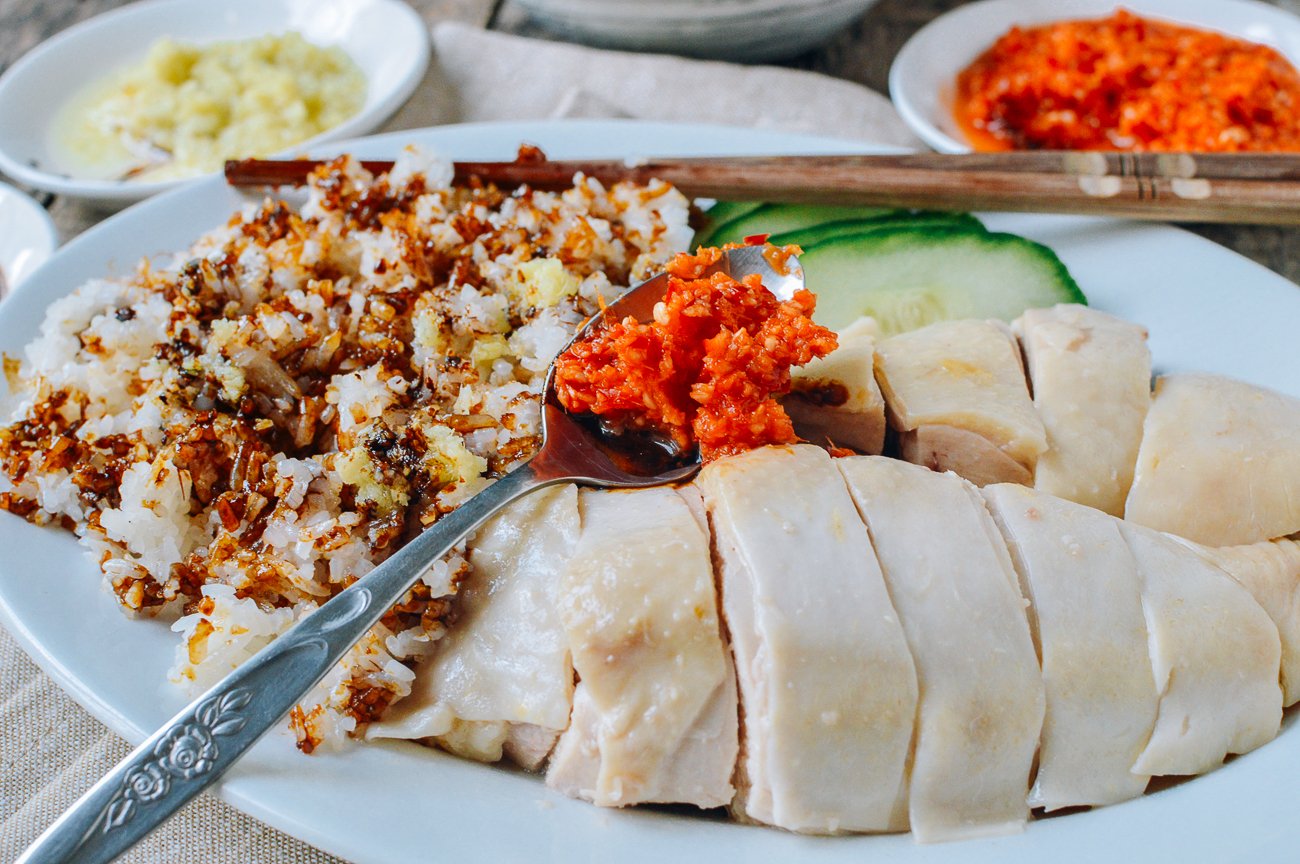With Lunar New Year coming up, many a Chinese table will soon be graced by a whole chicken. Whether it’s poached, braised, or salt-baked, a whole chicken is a deeply symbolic food in Chinese culture.
Today, we have a complete guide to preparing a whole chicken in the Chinese style, so you can keep this tradition going for generations to come!
Note:
We’re publishing this post is in partnership with family-owned Bo Bo Poultry Market. As always, all opinions are our own!
A Disappearing Art
A whole chicken is a symbolic food that many Chinese elders still prepare for their families during various Chinese holidays and celebrations.
Growing up, Kaitlin and I remember that not a Chinese holiday went by without a whole poached chicken (白切鸡 – baak chit gai in Cantonese or bái qiē jī in Mandarin) at the dinner table.
However, many in our generation are at a loss when it comes to preparing a chicken this way. You might even be intimidated by roasting a whole chicken in the Western style (for which there are countless recipes out there), let alone preparing one in a traditional Chinese manner!
Like many traditional Chinese recipes, this type of cooking often remains in the realm of the elders. It can be hard to get every precise detail on a recipe out of your mom, dad, grandmother, or grandfather. Especially if there’s a language barrier.


So today, we’re reclaiming this disappearing art! We’ll talk about why cooking a whole chicken is an important tradition to carry on, key best practices, recipes, and how to carve that bird like a pro into pick-up-with-chopsticks bite-size pieces!
The Symbolism of a Whole Chicken in Chinese Culture
In Chinese culture, a whole chicken (which yes, must include the head and feet on) primarily symbolizes family unity or togetherness. By extension, it represents completeness, wholeness, luck, and prosperity.
It wasn’t always the case that one could pop out to the grocery store to pick up a whole fryer from the meat case.
In leaner times, when China was largely an agrarian society, a whole chicken would have been reserved for a special occasion—something to look forward to and share amongst the entire family.

These days, serving a whole chicken is especially important around:
- Chinese New Year: Also known as Lunar New Year or the Spring Festival, this is often the one time of year when Chinese families (especially today, when many younger folks are working in cities and their families are still in their home villages) gather together for an extended period of time to celebrate and prepare foods that symbolize family unity, wealth, and good luck for the coming year. Our Chinese New Year table is never without a whole chicken! Read more about Chinese New Year Traditions here!
- Mid-Autumn Festival: As the second most important Chinese holiday on the calendar, this holiday is all about gathering family together to celebrate the autumn harvest. The Mid-Autumn Festival is celebrated under the full moon on the 15th day of the 8th month of the Lunar calendar. Not only does that big round moon (along with all the mooncakes) represent family togetherness, a whole chicken on the table does as well!
- Qing Ming (Tomb-Sweeping) Festival: A whole chicken is also an important symbolic offering to ancestors—at any time really, but especially during Qing Ming, which is known in English as the Tomb Sweeping Festival. On this day in April (the 15th day after the Spring Equinox), families visit the graves of their ancestors to pray, tidy/plant flowers, and provide ritual offerings, which can include burning incense, symbolic “tickets” that allow ancestors to come to the living realm to visit with family, paper items representing money, gold bars—and increasingly these days, paper pieces representing clothes, cars or even cell phones—as well as food and drink! You might see items like fruit or special treats that the departed person loved, but the foundation of any offering are three items representing air, land, and sea: a whole chicken, a piece of pork belly, and a fish.
- Other Special Occasions: A whole chicken is also often served at Chinese banquets for weddings, birthdays, the birth of a baby, other holidays, or other celebratory occasions.
- During the Postpartum Confinement Period: While this is less of a symbolic gesture and more-so related to Traditional Chinese Medicine, it’s a no-less important time to serve a whole chicken. Many cultures around the world believe chicken soup to be a healing food, and Chinese culture is no different! You might see a whole chicken cooked with other medicinal ingredients, such as Chinese herbs, dried dates/jujubes, goji berries, and ginger, served to a new mom after she has given birth to help with the recovery process during her 30-day “confinement” or rest period.
In short, being able to make a whole chicken is an important piece of cultural knowledge!

Best practices for cooking a Whole Chicken The Chinese Way
While there are many ways to cook a chicken, here are a few best practices to start with:
1. Find a Buddhist-Style Chicken
This is our NUMBER ONE tip: For the best results in any Chinese whole chicken recipe, look for Buddhist-style chicken.
These are chickens that have been raised specifically for Chinese customers. They are often a breed different from your regular grocery store chicken that has been bred for rapid growth and maximizing the amount of breast meat to satisfy the western diet of boneless chicken products.
These color-feather broilers are traditional rustic poultry breeds which, although they have a narrower breast and therefore less boneless meat, are bred for flavor, making them well-suited for traditional recipes. They grow slower and more gradually (rather than being ready for market in as little as 5-6 weeks), giving them time to develop superior flavor and texture.
These chickens taste better, full stop. This is especially key if you’re looking to make a dish like Poached White Cut Chicken, which showcases the chicken in its purest form, without much seasoning!
The designation of “Buddhist-Style” refers to a USDA religious exemption—similar to Halal-style or Kosher-style chickens—and the fact that the chicken is sold whole with its head and feet on, as is preferred by many Asian consumers.

Fun fact from the original producer of the “chinatown chicken”
According to Anita Lee, whose family has been farming and selling Buddhist-style chicken for nearly 25 years, it’s not just the Chinese community that appreciates these slow-grown chickens.
Customers in the Latino, Nepalese, and other ethnic and immigrant communities also seek them out, because they taste more like what they’re used to chicken tasting like!
Bo Bo Poultry is a family-owned and locally-operated New York business. An original Chinatown icon that went into business in 1985, they were the first to raise and produce Hong Kong-style or “Buddhist” style chicken in the United States.
One generation later, Anita and her family still pride themselves on their heritage and caring practices to raise the highest-quality poultry and deliver it to people across the country. You might have seen them at Say Weee!
“Bo” means precious, because the Lee family’s poultry is special. Their poultry is raised slowly and humanely at the foot of the Catskill mountains for an unmistakable and delicious flavor and texture that just can’t be replicated. We love Bo Bo Poultry products because they help preserve the traditions and tastes of home for generations of diverse customers—like us! :)
If you’re able to get your hand on the signature young Bo Bo chicken or any of their other products, we highly recommend them. You can read more about their family business, Bo Bo Poultry Market in this New York Times feature!
You can find these Buddhist-style chickens in Asian markets or in well-stocked Latino or ethnic markets. They often have a tag attached to the wing that’s marked with words along the lines of “Buddhist-exemption” or something similar. Generally, though, if the head and feet are still on the bird, it’s a Chinese-style chicken.
The next best option would be to buy a free range heirloom or heritage breed bird from a local farm or grocery store. These chickens can indeed be pretty pricey, so reserve them for cooking whole, and prepare them with care!
2. Make Sure the Chicken is Clean Before Cooking
This one always gets us into trouble, because so many people are squeamish—or downright fanatical—about raw chicken in the kitchen, and the FDA has released a recommendation to not rinse or wash raw chicken before cooking.
Many people dismiss the practice of rinsing chicken or other meats as simply a cultural thing—a remnant of that old agrarian society in which you were probably raising your own chickens for meat, plucking them, and processing them yourself. However, there is a practical and culinary purpose as well!
Depending on how the chicken was processed, you may be left with some blood/organ tissue in the cavity of the chicken, which can affect its flavor after cooking—especially in a dish like Chinese Poached Chicken/White Cut Chicken. Thoroughly rinsing out the cavity to remove any of that stuff is very important. You’ll ultimately get a cleaner flavor in the final dish.
Just be sure that when you’re cleaning your chicken, there’s nothing else in or around your sink to create cross-contamination. After you’re done, disinfect your sink and kitchen surfaces thoroughly!

Read more about our stance on rinsing/washing meat in this piece we were interviewed for by the Food Network. We talk about both the cultural and practical reasons behind it!
3. Allow the Chicken to Come Close to Room Temp Before Cooking
Your chicken shouldn’t be cold when you start cooking it—and certainly not partially frozen. It’s important that it is fully thawed. Also let it sit out on the counter for about 2 hours to come close to room temperature before cooking.
This goes for not only whole chickens in any Chinese recipe, but also for cooking a regular roast chicken. Having cold spots in your chicken will result in uneven cooking. In other words, some parts of the bird may be cooked, while others are underdone. You definitely don’t want that!

4. Empty the Chicken Cavity of Cold Liquid When Poaching Or Braising
In a similar vein, it is important to be aware when poaching or braising a whole bird—if making White Cut Chicken or Soy Sauce Chicken, for instance—that after you lower the bird into the cooking liquid, the temperature of the liquid inside the cavity and surrounding the bird will be different!
This can cause that uneven cooking problem we mentioned in our previous tip. To solve this issue, it’s crucial that you let that liquid come back up to a simmer, and then carefully lift the chicken out of the pot to release that pocket of cooler liquid in the cavity.
Once the cavity has emptied, you can lower the chicken back into the pot.

This, again, is to ensure even cooking of the bird. Chinese cooks NEVER overcook chicken (at least ideally).
It is critical, therefore, that none of these cold pockets interfere with your cook time. You want the dark meat and breast meat to all be juicy and cooked at the same time.
5. COOK Low & Slow
This applies especially to poaching/braising a whole chicken in liquid. The poaching liquid should barely be at a simmer. It should be bubbling gently to cook the chicken slowly and not dry it out.
This ensures that the chicken has the best possible texture. The Cantonese describe this texture as “slippery,” or waat, in Cantonese. If you’ve had a perfectly cooked chicken from a Cantonese restaurant or at a Chinese grandma’s table, you know exactly the texture we’re talking about!
Another low and slow Chinese cooking method is salt-baking, in which the chicken is wrapped in a thick layer of salt, which evenly and slowly transfers heat to the chicken for spectacularly juicy results!
6. Serve the ENTIRE Chicken, From Head to Feet
It’s not just about cooking the chicken whole—it’s about serving it that way too! The entire bird should be on the plate, including the head and feet. This is important to the symbolic meaning of the dish!

7. It’s OKay—even Ideal—to Serve at Room Temperature
If the chicken has been poached or braised, it is often best when served not piping hot, but at room temperature.
The chicken may even be plunged into an ice bath right after cooking. This changes the texture of the chicken skin, making it snappy and almost crunchy.

It also stops the cooking process and prevents the chicken from overcooking. Lastly, this tightens up the meat, giving it that firm, “slippery” texture we talked about earlier.
CHINESE WHOLE CHICKEN RECIPES
We have several whole Chinese chicken recipes. Choose the one that means the most to your family, or that looks tastiest to you!
1. Whole Poached Chicken
This is a Cantonese classic, and to us, it’s chicken in its purest and most delicious form. It’s all about bringing out the texture and taste of the chicken itself. It is served very simply, with a raw ginger scallion dipping sauce. Of all the ways to cook a whole chicken, this is the one we turn to most!


2. Soy Sauce Chicken
If you’re looking for something a bit more aromatic, try our soy sauce chicken. It is similarly poached/braised, but in a seasoned master sauce consisting of light soy sauce, dark soy sauce, sugar, and rose-scented wine. You can actually freeze the braising liquid to use again!


3. Black Silkie Chicken Soup
Here’s one of those medicinal chicken soups we mentioned earlier! It has various Chinese herbs in it, along with ginger, dried dates, and goji berries. While it may be unusual that the chicken itself has black skin (even the meat and bone underneath is tinged grey/black), its flavor is pure chicken!


4. Salt Baked Chicken
Here is that other famous Chinese whole chicken cooking method! The salt isn’t there to flavor the chicken so much as to evenly transfer heat—to cook it low and slow and give it an extra succulent texture and juiciness after it’s done cooking. We didn’t photograph this recipe with a Buddhist-style chicken, but using one would bring this recipe over the top!


5. Hainanese Chicken Rice
This recipe is Singapore’s national dish. It’s basically a white cut chicken, served with rice that’s been cooked in the stock from poaching, and a trio of delicious sauces. Make it to find out why Singaporeans love it so much!


How to Carve a Whole Chicken in the Chinese Style
Once you’ve cooked that bird, how do you carve it so that it looks great on the serving platter, and can be picked up with chopsticks?
Luckily my dad has written a step-by-step post on how to carve a whole chicken like a Chinese chef. That post has every tip, trick, and detail you need, as well as step-by-step photos.
Generally, though, you’ll want to use a large, solid cutting board—with grooves around the edge to catch any juices if possible. The best tool is a heavy Chinese cleaver.
Learn more in our post on How to Carve a Chicken Chinese-Style.


We hope you’ve enjoyed our comprehensive guide to preparing a whole chicken the Chinese way! Comments, questions, or memories to share? Let us know in the comments section below!




